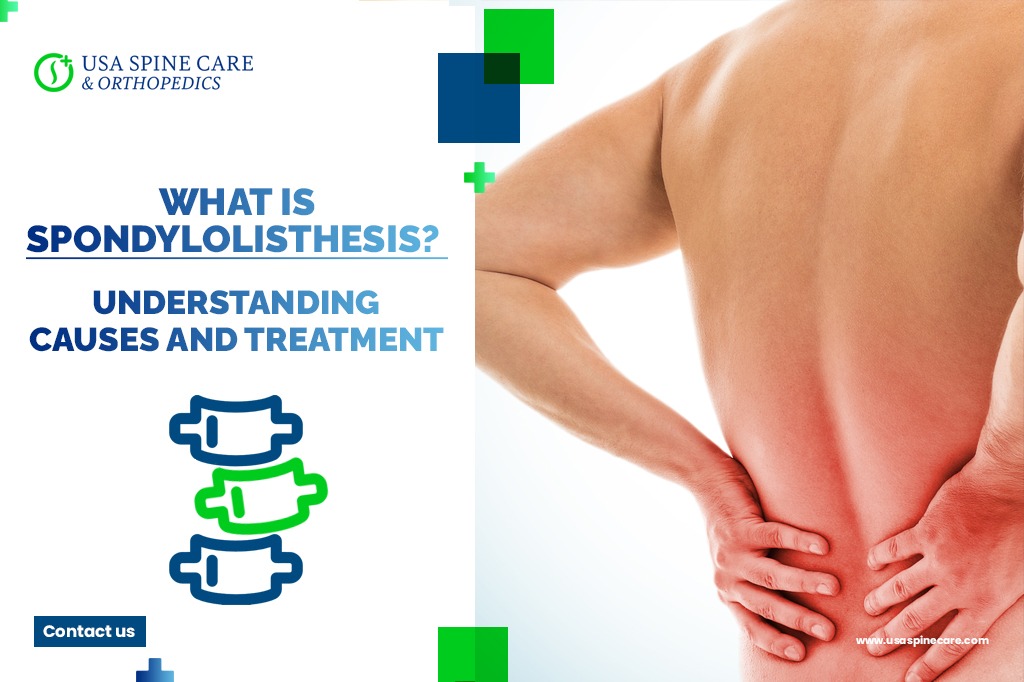- Conditions
- Procedures
- Patient care
- Why choose us
- Our Doctors
- Contact
What is Spondylolisthesis? Understanding Causes and Treatment

Spondylolisthesis is rooted in the Greek terms for “spine” and “slipping,” so it literally means spinal slipping. It can be a relatively common cause of spinal instability and lower back pain. Spondylolisthesis happens when an injury or condition causes a vertebra, usually in the lumbar (lower) region, to begin to slip out of its place in the spinal column.
Although it is not always painful, spondylolisthesis can cause painful nerve compression that leads to lower back pain and radiating symptoms into the lower extremities. It is also a source of spinal instability that can limit movement and disrupt your quality of life.
To learn more about causes and treatment options for spondylolisthesis take a moment to read the following guide. If you have any questions, don’t hesitate to reach out to one of our representatives.
Causes of spondylolisthesis include fractures and degenerative disc disease
A frequent cause of spondylolisthesis is a fracture in the facet joints that link the spinal column. This causes instability in that vertebra that can cause it to slip forward over the vertebra beneath it. Another term for this type of fracture is spondylolysis.
Another common form of spondylolisthesis is called degenerative spondylolisthesis. A condition such as degenerative disc disease can cause the spinal discs, which normally act as cushions, to wear out and become thin. This can lead to abnormal bone growth and the development of an unstable surface that causes slippage.
Spondylolisthesis can also be caused by congenital defects in the formation of the spinal column at birth that can lead to a greater likelihood of vertebral slippage over time.
Diagnosing and treating spondylolisthesis
Patients with spondylolisthesis are usually diagnosed after complaining of symptoms including pain and stiffness in the lower back, muscle spasms, pain when bending over and difficulty standing or walking. It is possible to have this condition for a long time without knowing it, with pain and symptoms developing as a result of displaced spinal anatomy causing nerve compression.
Patients typically undergo a thorough physical examination and diagnostic testing, such as MRI, X-ray or CT scan to determine if vertebral slippage is the source of symptoms.
Spondylolisthesis is graded on a scale of one to five, called Meyerding classification, according to the degree of slippage:
- I — Less than 25% slippage
- II — Less than 50% slippage
- III — Less than 75% slippage
- IV — Less than 100% slippage
- V — Total, or 100% slippage, also known as spondyloptosis
The minor types of spondylolisthesis are typically treated with conservative therapies designed to ease pain and improve mobility. Patients with degenerative disc disease and facet joint arthritis typically explore similar options. This usually includes:
- Rest
- Bracing
- Physical therapy
- Spinal injections
- Over-the-counter medication
Spine surgery is usually recommended for patients with higher grade spondylolisthesis, as well as patients with severe pain that does not respond to conservative therapies. The specific approach to surgery varies on a patient to patient basis. The primary goal of surgery may be to relieve painful nerve compression, or a spinal fusion or stabilization procedure may be the best course of action if there is severe and debilitating instability due to spondylolisthesis.
Reach out to the caring experts at USA Spine Care for spondylolisthesis treatment
At USA Spine Care, our highly skilled surgeons and multidisciplinary specialists can help you develop an effective treatment plan for any step of your spondylolisthesis treatment journey. We’re committed to patient-centered, personalized care that is right for your personal needs and treatment history. From physical therapy and pain-relieving injections to minimally invasive outpatient spine surgery at our state-of-the-art facilities, our mission is to get you back to the healthy and active lifestyle you deserve.
Contact us today to learn more.
Spondylolisthesis Quick Answers
How do you fix spondylolisthesis?
Spondylolisthesis is usually treated with conservative therapies designed to manage symptoms and improve functioning. If the degree of slippage becomes too severe and is causing pain, spine surgery can help relieve nerve compression. In some cases, a stabilization procedure will be recommended to treat the slippage.
Is spondylolisthesis serious?
Spondylolisthesis ranges in severity from mild to total slippage. The most serious cases of vertebral slippage can cause debilitating pain and spinal instability. In these cases, surgery may be indicated.
What happens if spondylolisthesis is left untreated?
Spondylolisthesis is often a progressive condition. If left untreated, there is a higher risk of the vertebra to continue slipping out of position into the spinal column. Total displacement can result in severe pain and instability.
What is the difference between spondylolysis and spondylolisthesis?
Spondylolysis describes a small crack or stress fracture in one of the vertebrae caused by injury or defect. This fracture can develop into spondylolisthesis, which is when a vertebral body begins to slip out of its normal position in the spinal column.
